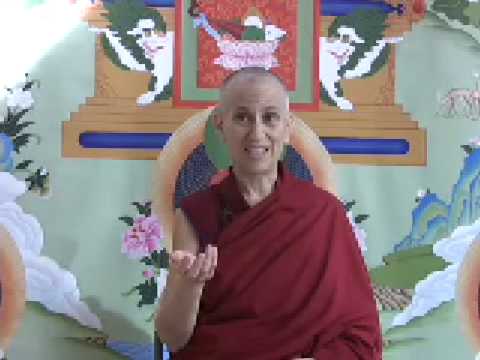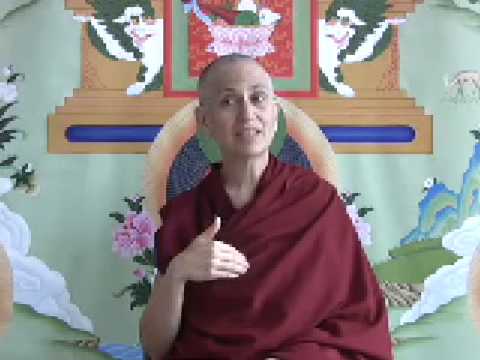Emptiness and the object of negation, part 2
The second of three talks on emptiness and the object of negation for the Bodhisattva's Breakfast Corner.
We say, “There’s the chair,” but how do I know that there’s a chair? Well, there’s the appearance of gray that is in a certain shape, and I’ve touched it before so I know it’s hard, and I’ve sat in it so I know that it can be used for sitting on, and so on. So, what’s appearing is just the qualities. It’s the gray that’s appearing to my “eye” consciousness. If I sit in it, the hardness is appearing to my tactile consciousness. If I took away the appearance of all those different qualities—if in my mind if I subtracted the appearance—then I still should be able to find something that is the essence of being a chair because I perceive that as being a chair from its own side.
Questions & Answers
Audience: Where does conventional reality come in?
Venerable Thubten Chodron (VTC): Conventionality says that there’s a chair that exists by being merely imputed. But beyond being merely imputed, there is no chair.
Audience: But we can use it.
VTC: We can use it even though it’s merely imputed. We use it even though it’s merely imputed.
Audience: So, my mind is trying now to make the conventional reality a solid thing.
VTC: Exactly. That’s what we continuously do; we’re continuously looking for something to hang on to. Okay! We think, “Oh, it’s a mere appearance, but it is really a mere appearance. It’s a real mere appearance.” [laughter] It exists by mere name, but there’s something inside it that enables me to give that name to it, or not some other name to it. That’s the Svatantrika viewpoint. So, we’re always looking for something to hang our hat on, which is why this meditation is very difficult, because we can’t separate what appears and what we think is there. And we can’t separate conventional reality from what we’re seeing.
Audience: We just keep grabbing.
VTC: We keep grabbing. I mean, the thing is we can’t identify the object of negation and that just keeps coming again and again and again and again. And I think a lot of our problems in understanding is that point. I didn’t understand years ago when I was studying with Geshe Sonam Rinchen, and we were studying Madhyamakavatara, and he would say these things and we’d say, “Gen-la, that doesn’t make any sense! What are you saying? It doesn’t make sense.” And he would just say, “You don’t understand what the object of negation is.” And we would say, “Yes, we do! The object of negation is inherent existence. And he says, “Yeah, you know the words; but you don’t know what you mean by them because you can’t identify the object of negation.”
Audience: I think, for me, the example of the chair is really difficult because when you first started off, and you said that it’s like, “How do I remove the appearance of the chair without taking the chair and putting it outside?” [laughter]
VTC: No, it’s mentally—mentally you remove.
Audience: And I think the reason is because I sense it in so many different ways—with all of my sense consciousnesses. I can taste the chair. I can smell the chair. But, if I take a sound that can only appear to one sense consciousness, and then if I just remove the sound, I should still be able to, at least, sense it with my other sense consciousnesses, if it inherently exists. I should be able to see it.
VTC: No, you can’t see sound, can you?
Audience: No, exactly. But if it inherently exists then I should be able to.
VTC: No.
Audience: Why not?
VTC: Because it’s only the ear consciousness that can hear sound.
Audience: Well, yeah.
VTC: So, it inherently exists as an object of your auditory consciousness. If somebody’s screaming, “You idiot!” that seems pretty real. Doesn’t it? Now if you took away the appearance of that sound, it seems like there should be something there.
Audience: It should be sensed in some way.
VTC: Yes. You bet.
Audience: But not necessarily. I should be able to smell it or see it, but I should be able to sense it outside of just sounds. But that’s all it is—the sounds.
VTC: Yes. But take away that appearance and what do you have left? But if it inherently existed you should have something left. It’s like you look at a person and it’s a real person there. And you feel like there’s a real person inside there. Well, that would mean that if you took it apart, part by part, you should still find the real person there. So, in a similar way here, you just take away the appearance of the person, you still should find something there, something beyond the appearance, something that’s inherently existent. In neither way can we find anything.
Audience: But if you take away the appearance of the chair, it doesn’t mean that nothing is there. It means the chair is not there. Right? Is that right? If you take away the appearance.
VTC: If you take away the appearance of a chair, if a chair inherently existed you should find the chair there.
Audience: But if I take away the appearance of the chair, and I don’t find the chair, it doesn’t mean there’s not anything there. Because there has to be something upon which I…
VTC: You are mentally taking away the appearance.
Audience: I understand that. But what I’m trying not to do is think, “Oh, nothing exists.” So, I’m trying to…
VTC: The basis of imputation is there.
Audience: So, something is still there.
VTC: Yeah, but the basis of imputation also isn’t inherently existent. [laughter] “Okay.” [laughter]
Audience: The vacuum of space. That’s where I go when you take away the appearance of the chair. What’s there? Nothing but a big black hole. And that’s not right?
VTC: No.
Audience: Okay.
Audience: But what’s left there is also not inherently existent.
Audience: Can we move this into the equanimity meditation? Because, like Kathleen was saying, you want to grab something. So yes, I can equalize my feelings—well, equalize is probably not the right word—but I can have an equal openness towards all three of those categories or people in those categories. But still, when I come back to my conventional dealings with those three categories of people, it’s still a challenge to think, “Well, how do I interact with someone I really do feel a genuine sense of closeness with versus someone I feel consternation towards?”
VTC: Yes. Because we go right into grasping at true existence. We go right into it. I mean, look, we’ve been familiarized with grasping at true existence from beginningless time. This ain’t going to go away quickly, folks!
Audience: So, Venerable, after this intellectual—for me it’s certainly an intellectual exercise— what’s the relationship then to taking it one step further to see what we actually are calling whatever is left? What do we do after?
VTC: We’re jumping back to how do we get something to inherently exist after we’ve taken away the appearance. Let’s just focus on taking away the appearance without taking the chair away out of the room: without taking this basis out of the room, take away the appearance of the chair.
Audience: It was easier when you were talking about Diane (in part 1). I understand much more than I do when looking at an object or an entity that I interact with. It was much more palpable for me to think, “Oh, yeah, there’s something still there when I say ‘Diane’ rather than ‘the chair.'” With the person, there’s much more. It seems like there’s still something there.
VTC: There’s something in the body and mind that is personal. But if you look, what is personal within the body and mind? What is personal? It’s totally nuts!
Audience: Which one? [laughter] My personal one that sees this, or my personal one that hears that? Which consciousness?
Venerable Thubten Chodron
Venerable Chodron emphasizes the practical application of Buddha’s teachings in our daily lives and is especially skilled at explaining them in ways easily understood and practiced by Westerners. She is well known for her warm, humorous, and lucid teachings. She was ordained as a Buddhist nun in 1977 by Kyabje Ling Rinpoche in Dharamsala, India, and in 1986 she received bhikshuni (full) ordination in Taiwan. Read her full bio.


